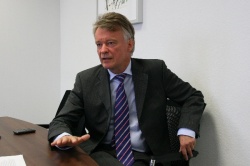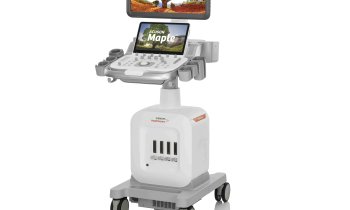Where are we - and what lies ahead?
In a European Hospital interview Professor Herman Requardt, Head of Corporate Technology and CEO of Siemens Healthcare Sector, offered his views on current and future healthcare manufacturing needs as well as the market challenge arising from the dynamic economic ascent of other nations.

In 2006, Prof. Requardt received an Honorary Professorship (Physics) at Johann Wolfgang Goethe University in Frankfurt.
In his current roles as CEO of the Siemens AG Healthcare Sector, Head of Corporate Technology and a Member of the firm’s Managing Board.

In 2006, Prof. Requardt received an Honorary Professorship (Physics) at Johann Wolfgang Goethe University in Frankfurt.
In his current roles as CEO of the Siemens AG Healthcare Sector, Head of Corporate Technology and a Member of the firm’s Managing Board.
‘Healthcare costs are continuing to increase substantially throughout the world,’ Prof. Requardt pointed out. ‘That development can be attributed, first of all, to demographic trends: life expectancies are rising almost everywhere in the world. And that, in turn, is one of the main reasons why the world population is increasing. More than nine billion people will live on our planet by the middle of this century. Today, the world population is slightly less than seven billion.
‘However,’ he added, ‘another factor behind rising healthcare costs is the equation that still applies today: Better medical care equals higher costs. Obviously, this phenomenon cannot go on forever. We are working on ways to make an inequation out of this equation. In other words, better medical care at constant or even falling costs. That is indeed possible, but it will take innovations. Such as innovations in the areas of imaging techniques, for example: Faster, more precise diagnoses allow for earlier and more targeted therapies. Or also innovations related to the wider use of IT systems in healthcare: Faster and better-coordinated work steps in hospitals and medical practices lower the number of multiple examinations, saving time and money. And innovations in the area of laboratory diagnostics: The ability to identify a genetic predisposition quickly and precisely makes it possible to assess the probability that certain therapies will be successful.
‘Thus, we are confronted with a qualitative and a quantitative challenge: We need to provide better healthcare than before, to more people than ever before. We are on the forefront of the efforts to solve this problem!’
Asked about the potential impact of competition from China, Prof. Requardt said he would not limit this to the Chinese alone. ‘As we see it, competition is intensifying on several levels. First, certain well-established competitors are stepping up their research and development efforts considerably. To counter that trend, we need to defend and extend our position as an innovation leader. Second, large corporations from the IT sector, for example, which had hardly been active in the medical engineering sector before, are now venturing into these markets to a heightened degree. And third, new competitors are rising up in the emerging-market countries, as they seek to capture a strong share of their fast-growing home markets. On the other hand, we are also seeing new opportunities for us in the mid-price segments of these markets. Thus, the competition landscape is becoming more diverse, and so are the opportunities.’
Do new medical approaches, for example, the emergence of interdisciplinary teamwork, involving physicians from all specialties to focus on a tumour therapy, mean new ways of thinking are needed? ‘In oncology especially, the expertise of radiologists is increasingly in demand in all phases of the healthcare process, from diagnosis to therapy and follow-up care. The data and findings of different departments need to be combined, in order to represent the patient both in his entirety and in his individuality,’ Prof. Requardt pointed out. ‘For that purpose, Hospital Information Systems (HIS) and Radiology Information Systems (RIS) need to be networked throughout the institution.
‘Furthermore, hospitals need to communicate externally as well, specifically with the patient’s regular doctor or practicing specialist, who have known and provided medical treatment to the patient for a longer period of time. In a sense, all healthcare providers just need to agree to share specific patient data and diagnoses with each other, so as to arrive at a common, complex and individualised understanding of the disease and apply the best therapy. That is a technical (IT) challenge. But, even more, it represents a mental challenge for the healthcare providers involved.’
Are the changes in radiological practice cause for concern or do they present opportunities for Siemens? ‘That,’ he responded, ‘is a complex question. I understand it to mean, first of all, that diagnostics and therapy are increasingly converging. Indeed, that is a trend we are monitoring. And that trend is being driven by the clinical presentation, which plays a crucial role in early detection and prevention, and in the planning, administration and monitoring of therapy.
‘Another important development is image-guided, minimally invasive surgical techniques in oncology and cardiology. The advantages include higher therapeutic success and less strain on the patient, as well as time and cost advantages.
‘We definitely see a great opportunity in this trend. Therefore, our new organisation, which entered into effect on 1 October 2010, reflects this trend exactly.’
How will Siemens Healthcare benefit from or be altered by acquisitions? ‘In 2006 and 2007 we strengthened our business through three acquisitions: Diagnostics Products Corp. (DPC), Bayer Diagnostics and Dade Behring. Naturally, integrating these companies into our Diagnostic Products Division posed a challenge, especially considering the fact that the integration had to be handled in the midst of an economic crisis of historical proportions. Though we have achieved our cost objectives in the course of the integration, we still have some work to do on the growth side, which we are now tackling with our full attention. Thanks to our entry into the field of laboratory diagnostics, however, we are now the only fully integrated supplier, offering products for every phase of the process, from preventive care to diagnosis and therapy to follow-up care. We are very proud of this prominent position. But that also means we need to lead the field of competitors in all areas in which we operate.
Which markets are most important for Siemens? ‘The United States is still the biggest market and will continue to be so in the coming years. We generate slightly more than 40 percent of our revenues in that country. The greatest growth, on the other hand, can be found in the emerging-market countries, especially China and India. In those countries, the dynamic growth trend will continue and could even accelerate. A key element of the next five-year plan of the Chinese government, which will take effect as of 2011, is to expand healthcare. And we intend to capitalise on the opportunities that will create for us.
How important is the healthcare business for Siemens as a whole? ‘The Healthcare Sector accounts for 15 percent of the company’s revenues and nearly one fifth of the profits of the company’s Sectors. That speaks for itself. In addition, Siemens Healthcare is one of the most important innovation engines of Siemens, and therefore also an important initiator for topics that affect the overall company. One such example is the sustainable development of our cities. This topic is very high on Siemens’ agenda; and, for that purpose, Siemens Healthcare has launched its own programme for hospitals: Green+Hospitals.
Is the company seeking new acquisitions to strengthen its position in, say, the operating theatre, or robotics? ‘Our business is very well aligned. Our new organisation will help us to address new growth markets in emerging-market countries in a targeted way. In addition, the new organisation reflects new, pioneering trends, such as the convergence of imaging techniques and therapy, which I mentioned before. We have created the conditions that will enable us to grow our business on our own strength. And that’s what we are focusing on now.’
28.10.2010











